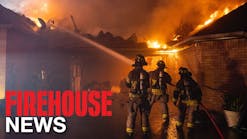Cardiac Arrest Survival Rates Triple For Ariz. FD
Source The Explorer (Tucson, Arizona)
Survival rates have more than tripled for cardiac arrest patients in the Northwest Fire District (NWFD) as a result of a new treatment protocol and a close partnership with the University of Arizona Medical Center (UAMC), the hospital that provides the fire district’s medical direction.
The data show that, just eight months after implementing a new, state-approved treatment standard for patients who experience “Sudden Cardiac Death,” Northwest Fire has dramatically increased the chance of survival in two key cardiac arrest categories they monitor compared to the previous year:
All incidents of cardiac arrest (bystander witnessed or not, with a “shockable” heart rhythm or not) now have a 14.6 percent chance of survival compared to 4.9 percent reported prior to the new treatment protocol
Bystander-witnessed cardiac arrest in patients with a shockable heart rhythm now have a 37.5 percent chance of survival vs. 11.1 percent reported prior to the new treatment protocol
The cardiac arrest treatment model now used by NWFD is called Minimally-Interrupted Cardiac Resuscitation, or MICR, and the protocol went into effect in January of this year. NWFD has now joined other emergency medical services (EMS) agencies throughout the state in demonstrating just how effective the alternate EMS system cardiac protocol can be by reporting patient outcomes through to hospital discharge. This is accomplished because both NWFD and Tucson-area hospitals report treatment information to SHARE (Save Hearts in Arizona Registry and Education), a state health department program that partners with EMS providers to maintain records on cardiac arrest incidents (www.AZSHARE.gov).
This unified patient reporting structure not only demonstrates that more lives are being saved through NWFD’s implementation of MICR, it also shows that most of the patients who survive are doing so with very good neurological status. This is extremely important since neurological compromise is a very common complication of cardiac arrest (contrary to the perception of CPR survivors portrayed on TV where the common storyline is that the patient is shocked by paramedics and immediately wakes up).
Brad Bradley, Division Chief of Operations at the Northwest Fire District says, “We’re very encouraged by these results. Even better…we’re just getting started. It was a lofty goal to get to the survival numbers we’re looking at as quickly as we have, and in our partnership with UAMC, we believe the other measures we will be implementing will very likely lead to the survival rates climbing even higher. Together, we’ll continue to be proactive in our treatment approach, collaborate with our partners on their approach, and engage the community in learning Chest Compression-Only CPR to get the process started before we’re even dispatched. We’re very confident that, in the future, we’ll be saving even more lives, at a higher quality of life.”
According to Dr. Dan Spaite, Professor of Emergency Medicine at the University of Arizona College of Medicine and EMS Medical Director for the Northwest Fire District and UAMC, “We are delighted to see the exceptional focus that Northwest Fire has placed on saving lives from one of the top causes of death in the U.S. Their commitment to providing optimal treatment and reporting their outcomes through the SHARE Program have led to a documentation of dramatic improvements in a remarkably short time.”
Copyright 2012 Explorer Newspapers, Inc.Distributed by Newsbank, Inc. All Rights Reserved






